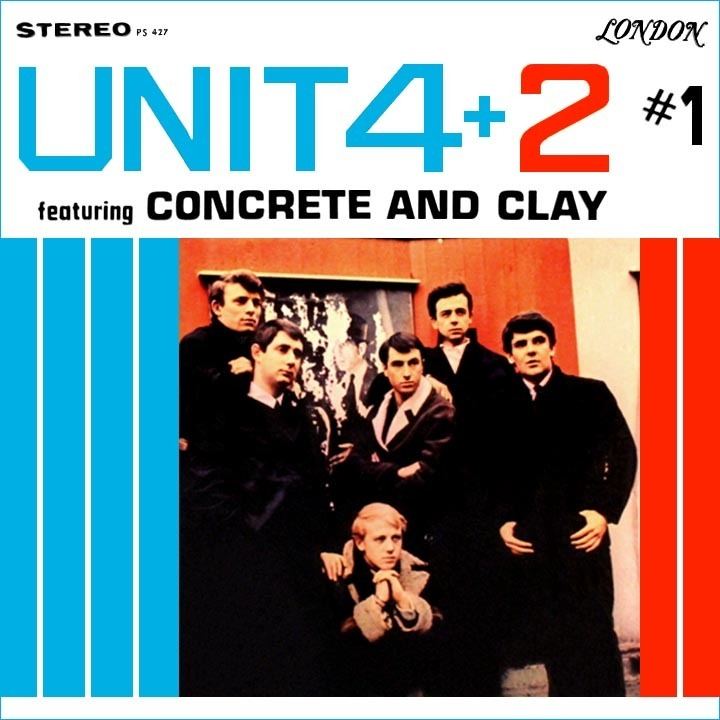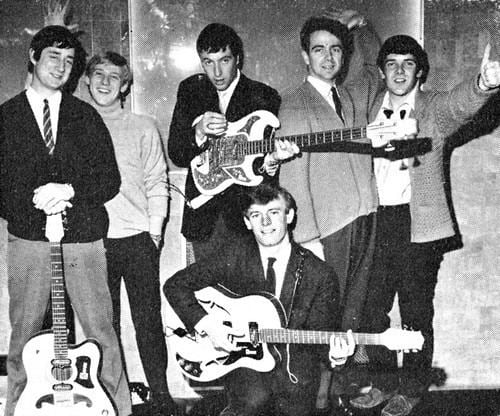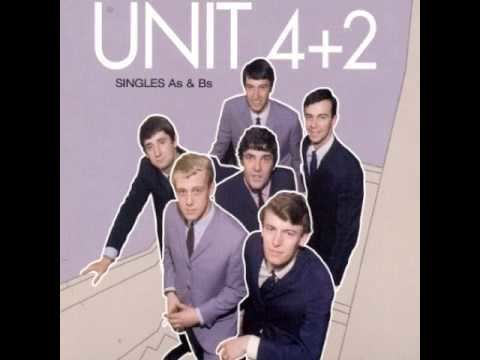Genre Pop rock | Years active 1963–1970 | |
 | ||
Past members Brian ParkerTommy MoellerBuster MeiklePeter MoulesHoward 'Lem' LubinRod 'Humble' GarwoodHugh HallidayNigel SnookRuss BallardBob Henrit Glyn Havard Tony Duhig Allan Price Iain Hines Albums Concrete and Clay / Unit 4+2, Singles As & Bs, Best of Unit Four Plus Two, Vol. 2, Best of Unit Four Plus Two, Vol. 1 Members Russ Ballard, Tommy Moeller, Bob Henrit, Brian Parker, Howard Lubin | ||
Unit 4 + 2 were a British pop band, who had a number one hit in the UK Singles Chart in 1965 with the song "Concrete and Clay". The track topped the UK chart for one week.
Contents
- Unit 4 2 a place to go
- Early days
- Success
- Later years
- Cover versions
- Band member details
- Albums
- Songs
- References
Unit 4 2 a place to go
Early days

In 1962, Brian Parker, then the guitar player and songwriter with The Hunters, decided to form his own vocal harmony group. He asked his friend David 'Buster' Meikle to join him. They asked singer Tommy Moeller and Peter Moules, who were at school together, to join their group which they called Unit 4.

Unit 4 was later joined by Russ Ballard on guitar and Robert 'Bob' Henrit on drums (forming the + 2) for a six piece, four-part vocal harmony group. Moeller was lead singer and frontman, from the first show as the Unit 4 vocal group to the last show as Unit 4 + 2 as vocal group with instruments. Due to ill-health and a dislike of performing live, Brian Parker left the band, but remained involved as co-songwriter with Tommy Moeller for all of the band's original recordings. His place at live performances was taken by Howard 'Lem' Lubin. In around 1967 when they recorded their second album, Rodney Garwood replaced Peter Moules on bass (who had taken up bass when the band changed from a vocal group to a pop band) and Hugh Halliday replaced Bob Henrit.

As Unit 4 + 2, they issued their debut single, on Decca Records called "The Green Fields" (which included the only performance with the band of banjo player Nigel Snook) which reached number 48 in the UK in 1964. Their second single release "Sorrow and Pain" was less successful.
Success

Unit 4 + 2's song "Concrete and Clay" became a big hit the following year, reportedly thanks to exposure on pirate radio stations, most notably Wonderful Radio London. The radio station's music director, Tony Windsor, later recalled in an interview that he had initially rejected the song for the station's playlist, but was persuaded to change his mind by DJ Kenny Everett. The song was recorded with session musicians Russ Ballard and Bob Henrit (who had played with the Roulettes). As well as reaching the top of the UK chart, "Concrete and Clay" was popular worldwide. In America, a competing cover version by Eddie Rambeau (produced by Bob Crewe) split sales, with Rambeau reaching No.35 on the Billboard Hot 100 and Unit 4 + 2 peaking at No.28. Cashbox bracketed the two competing versions together on its chart, and they reached a combined peak of No.12.
Decca released a hastily put together album, entitled 1st Album. The next single release, "(You've) Never Been in Love Like This Before", reached the Top 20 in the UK, and No.95 on the Billboard Hot 100 in America.
In 1967, Russ Ballard (who went on to form Argent) joined the band full-time, having already played some of the guitar work with Brian Parker on the original recording for "Concrete and Clay".
Later years
Unit 4 + 2 released 10 singles on Decca between 1964 and 1967 including one four track EP, and many of the songs ended up on their first album, 1st Album. The album later changed in title, cover art and track listing and was re-released as #1 featuring Concrete And Clay. Also, singles that became hits like the fifth single "(You've) Never Been in Love Like This Before", were not on the 1st Album, but were added on the re-released version.
Hugh Halliday replaced Bob Henrit for the second and final album in 1967 on Fontana Records. With Ballard and Henrit on board as full-time members, the Unit 4 + 2 sound had gelled, but their cover of Bob Dylan's "You Ain't Goin' Nowhere" was outsold by a cover version by The Byrds. Their last single, "3.30", used electric piano and other orchestration . The song appears on the 1984 compilation album, The 49 Minute Technicolor Dream. The B-side, "I Will", appeared on the 1984 compilation album The Psychedelic Snarl. "3.30" failed to chart, and with next album, Unit 4 + 2, also failing to chart, the group broke up in 1970.
The label change was a result of Decca being acquired, its new owners also owned Fontana. Unit 4 + 2 released six more singles on Fontana up to 1969, disbanding in 1970. One of the Fontana releases was for Spain, and was a reissue of the four tracks from two previous singles as one E.P. They briefly resurfaced for a tour of U.K. clubs during 1970 with Tommy Moeller remaining as front-man, but with an entirely new backing band. This was made up of Glyn Havard (bass and vocals), Allan Price (drums and vocals), Iain Hines (keyboards and vocals and Tony Duhig (guitar). The band only existed for approximately two months and then disbanded again. Havard, Duhig and Price went on to play in avante-guarde progressive group, "Jade Warrior".
Cover versions
"Concrete and Clay" returned to the Top 20 of the UK Singles Chart in 1976, courtesy of Randy Edelman's cover version. The song appeared on the soundtrack to the 1999 film, Rushmore.
Band member details
Albums
Songs
Concrete and ClayRush · 1999
Been in Love Like This Before1991
Baby Never Say Goodbye1993
